Recent Articles
Popular Makes
Body Types
2017 Dodge Challenger SRT Hellcat Road Test and Review

2017 Dodge Challenger SRT Hellcat Front Parked Flag ・ Photo by Miles Branman
When Dodge set its SRT Hellcat upon the automotive world in 2015, it was a bit like returning cannon fire to someone wielding a bow and arrow. The muscle car wars had intensified to a point of absurdity, with Chevy’s Camaro, Ford’s Mustang, and Dodge’s Challenger pushing engine output further and further. After Ford revealed its 662 hp Mustang GT500 in 2013, most people assumed we’d reached a climax. Then Dodge dropped the hammer. 707 horsepower, manual transmission, rear-wheel drive, burnouts in fourth gear; this was the Hellcat – an appropriate name for vehicular terror. Though Dodge’s Challenger and Charger Hellcats have remained the most powerful muscle cars you can buy, the American automaker took things a step further with the introduction of the Demon in April at the New York International Auto Show. With 840 horsepower, wider tires, and more sophisticated technology, the Demon will dethrone the Hellcat. Until then, though, the Hellcat was king, and those who don’t bow will be punished – severely.
What’s New for 2017
Though much of the Challenger SRT Hellcat remains unchanged for the 2017 model year, Dodge has rolled out a few tweaks to keep its raucous road car appealing. Most notably, Dodge’s 8.4-inch UConnect infotainment system gets an update, improving smartphone connectivity with Apple CarPlay and letting users access Google Voice Search, Google Maps and Google Play Music via the touchscreen or voice control. Beyond these functional changes, the system responds faster and has a more vivid display. Apart from the fourth-generation UConnect, Dodge added an illuminated SRT logo on the steering wheel, a new low-gloss black 20-inch wheel design, and four new paint colors: Destroyer Gray, Octane Red, Green Go and Yellow Jacket.
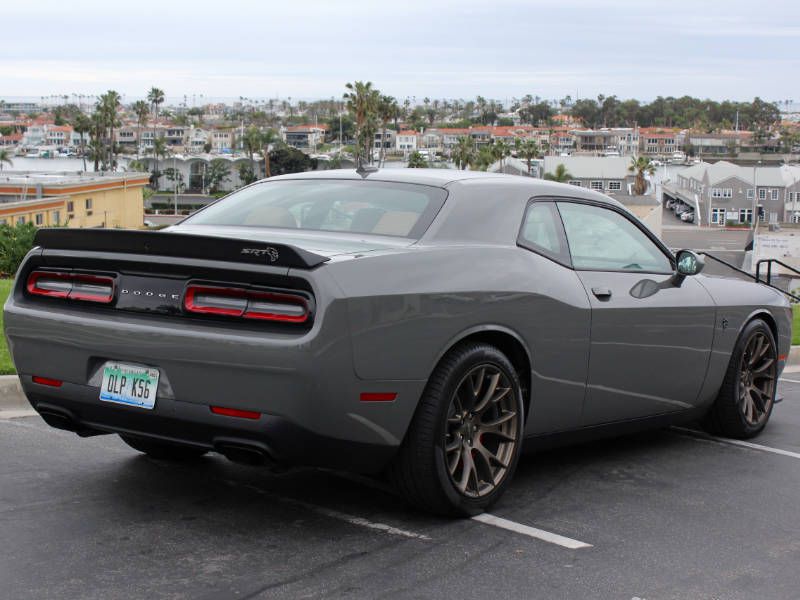
Photo by Miles Branman
Weaponized
The source of your joy and trepidation behind the wheel of the Hellcat is its 6.2-liter supercharged V8. 707 hp and 650 lb-ft of torque are routed to the rear wheels via a 6-speed manual transmission or optional 8-speed TorqueFlite automatic with steering wheel-mounted paddle shifters. With judicious throttle application, the Hellcat gets to 60 mph in 3.6 seconds (3.9 with the manual) and on to a top speed of 199 mph. For a higher top end, the Charger Hellcat will take you all the way to 204 mph. The Challenger Hellcat may be the only vehicle I’ve ever driven that will perform a burnout completely by accident. While you can reduce throttle response, increase stability control, or even cut power down to 500 horses (with the included black key fob), the engine will still overwhelm the rear tires easily. Worried about fuel economy? The Challenger Hellcat’s 16 combined mpg rating probably won’t thrill you, but long highway drives will return up to 22 miles per gallon.
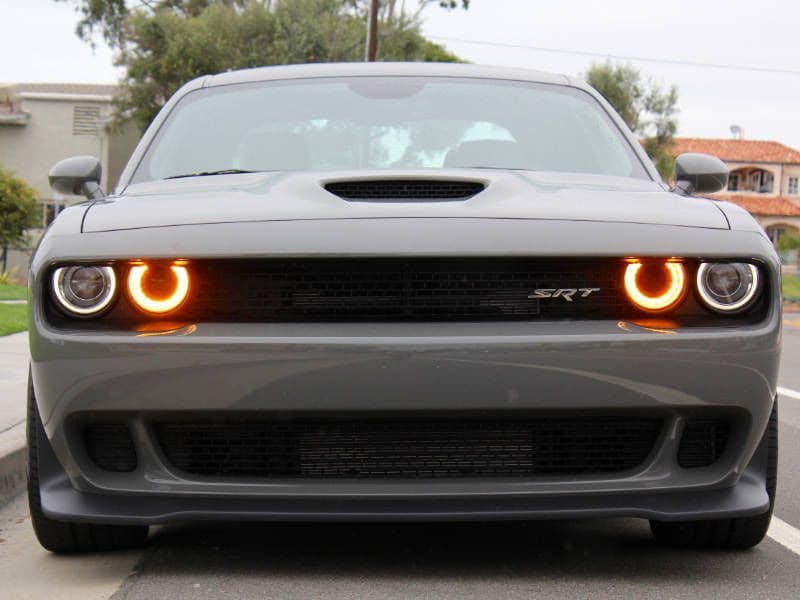
Photo by Miles Branman
Composed
Taking the reins of the Hellcat should be as daunting as riding a raging bull, but SRT’s engineering brilliance enables the 4,500-lb muscle car to behave predictably at the limit. Sure, you can go sliding around every corner if you so choose, but you can also whip the Hellcat around a circuit or back road at far greater velocity than one might expect. The key to the Hellcat’s handling sophistication is threefold. First, Dodge’s adaptive suspension system and beefier sway bars work together to make an old chassis feel young again. Next, Dodge’s intelligent traction management system (Default, Custom, Sport, or Track driving modes) will let you wag the Hellcat’s tail a little, a lot, or — if you turn off the system completely — until you’re facing the opposite direction. Finally, available Pirelli P Zero summer tires grip exceptionally well mid-corner — provided you don’t unleash full throttle on them. Then there are the brakes. Yes, I realize I said it’s a threefold handling equation, but the Hellcat’s brakes are so impressive, they deserve their own category. 15.4-inch front discs and 6-piston calipers are matched with 13.8-inch rear discs and 4-piston calipers for stopping power only Brembo can provide. Keeping this much power and weight in check is no small feat, but these brakes are up to the challenge(r).

Photo by Miles Branman
Imposing
Among the three muscle car contenders, the Challenger sticks closest to its ancestor’s long, wide proportions. The chunky design has serious curb appeal, but it also lends itself to a heftier curb weight than rivals. For my part, I find the Challenger’s big, brash body quite provocative. Distinguishing the Hellcat from the base Challenger or R/T model is pretty easy, but spotting the differences between the 707-horse monster and the still-insane, but not fully mental SRT 392 version is harder. Cues include small Hellcat badges on the driver and passenger side front quarter panels, one on the rear spoiler, a unique hood with an integrated air intake, and two unique 20-inch forged wheel designs. My tester is shod in stunning bronze “Brass Monkey” wheels, which pair well with the car’s Destroyer Gray paint job.

Photo by Miles Branman
Comfortable
The Challenger’s big bod pays off in more ways than one. Presence on the road is matched by good passenger volume for up to four occupants. Large, comfortable sport bucket seats cradle front occupants, and supportive rear chairs can accommodate two more average sized adults. Those with long torsos and legs will struggle with the low roof and tight rear legroom, but neither the Mustang nor the Camaro boast better setups. The cabin itself is a good mix of leather, high quality trim, and textured plastics. Leave the adaptive dampers in their softest setting and the Challenger transforms into a remarkably composed Grand Touring car.
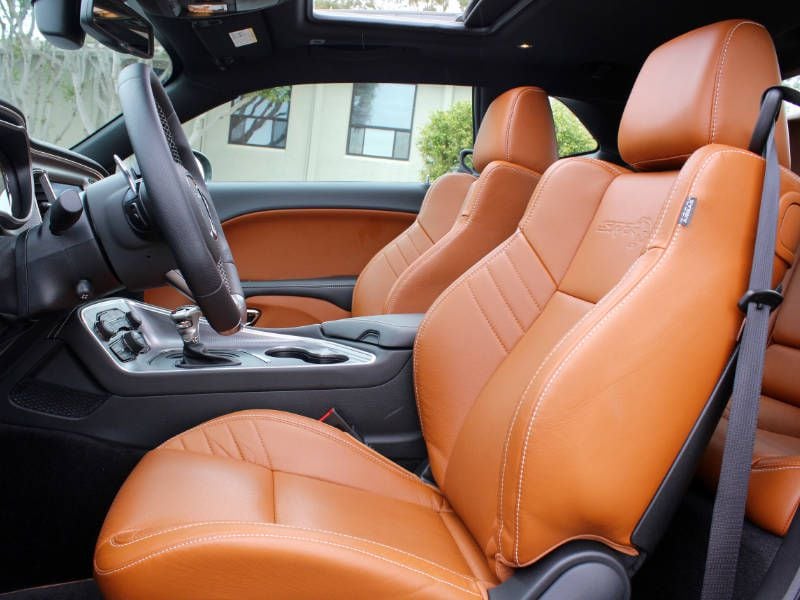
Photo by Miles Branman
Advanced
Part of what makes the cabin so inviting is its modern convenience features. Dodge’s latest UConnect infotainment system excels where other interfaces falter. The clear, responsive display is both intuitive and robust, letting the driver access climate, navigation, and vehicle dynamics settings in just a few taps. A 7-inch color TFT display mounted between the speedometer and tachometer also gives readouts on speed, fuel consumption, and audio info. Audio settings are also accessible via buttons on the backside of the steering wheel, keeping the driver’s focus on the road ahead (or sideways, depending on throttle application). The Challenger strikes a perfect balance between touch controls, voice command functions, and physical button redundancies.
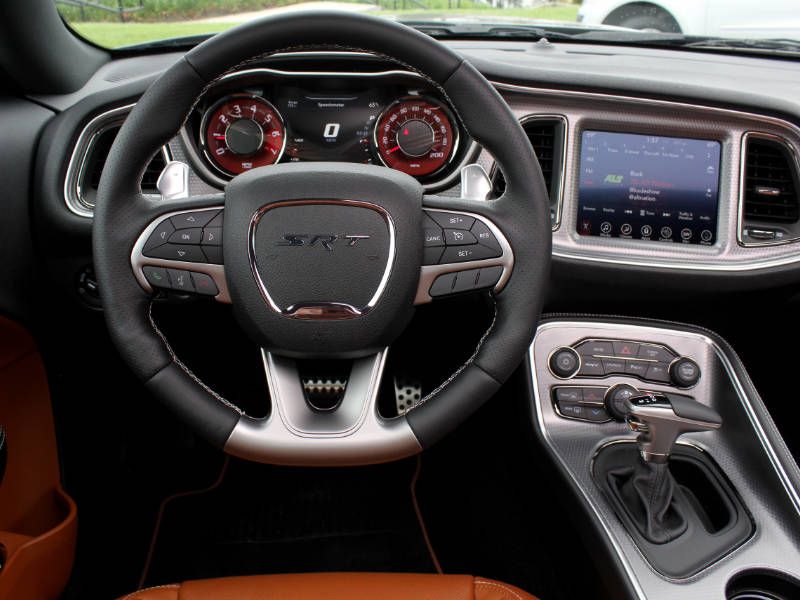
Photo by Miles Branman
Pricing
The Dodge Challenger SRT Hellcat isn’t just the most powerful muscle car you can buy; it’s also the most power per dollar on the market. Supercar levels of grunt will only set you back $62,495 (before $1,095 in destination fees and $1700 in gas guzzler taxes). Even factoring in the mandated expenses, customers are only looking at $93 per horsepower. The deal gets even sweeter when you factor in all the standard features. Some available extras include the 8-speed automatic transmission ($2,995), power sunroof ($1,995), summer performance tires ($695), and 20-inch "Brass Monkey" wheels ($995). Every Hellcat ships with HID headlights, LED daytime running lights, UConnect, a 7-inch driver display, power driver's seat, 18-speaker Harmon Kardon sound system (which sounds fantastic, by the way), heated and ventilated front seats, a heated steering wheel, dual-zone automatic climate control, a backup camera, parking sensors, Pirelli all-season tires, Sirius XM, Apple CarPlay and Android Auto, and keyless entry/ignition. You may be getting a mess of power on the cheap, but that’s only part of the Hellcat’s killer bargain.
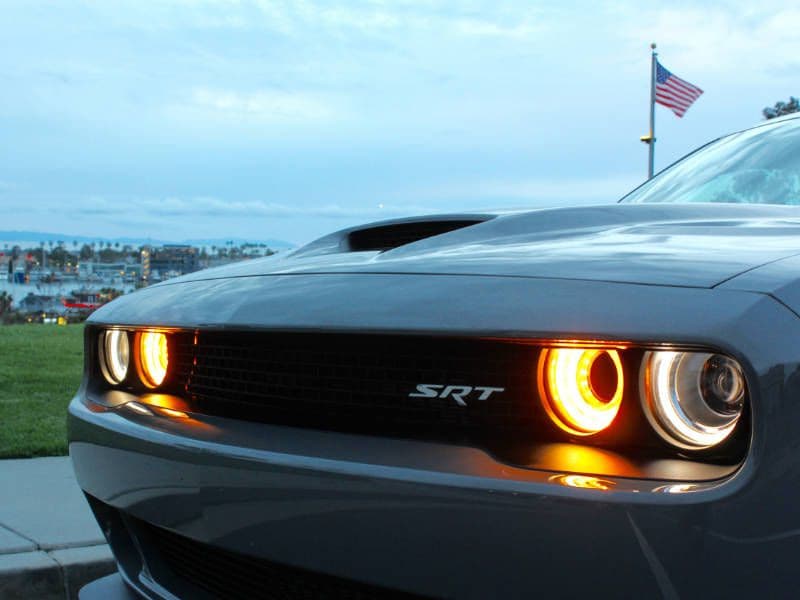
Photo by Miles Branman
Highs and Lows
Highs: - Raucous power - Smooth, fast, and responsive transmission - Astonishingly composed chassis, given the heft - Indomitable brakes - Comfortable and tech-laden cabin Lows: - Do I have to say it? Fine. Not the best fuel economy
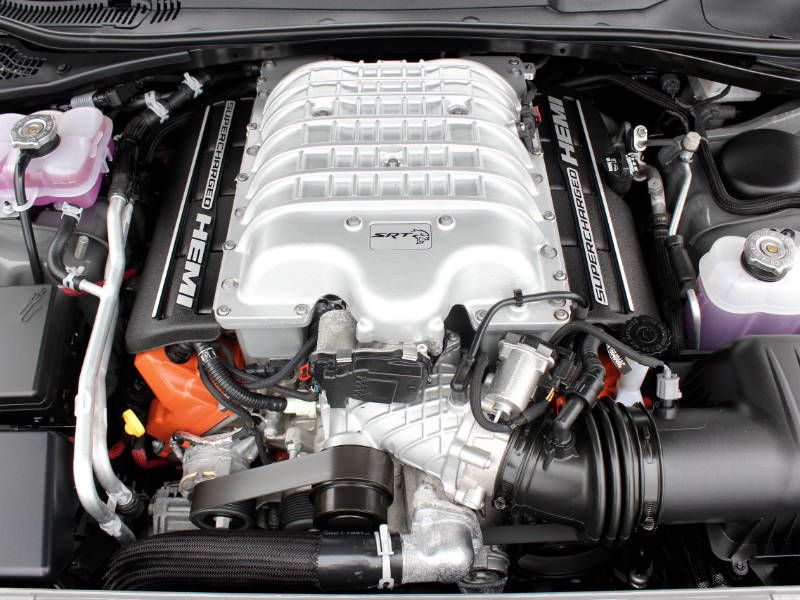
Photo by Miles Branman
Competition
With the Ford Mustang GT500 currently out of production, the Dodge Challenger SRT Hellcat occupies unique territory in the performance market. The Ford Mustang GT350R is better as an all-out track car for the same money, but it fades quickly into the Hellcat’s rearview mirror at the drag strip. More threatening to the Hellcat’s value proposition is Chevrolet’s new Camaro ZL1. Though tuned more for lap times, the ZL1’s lighter figure, wider tires, and meager power deficit (57 horses) leads to a slightly quicker 0 to 60 mph sprint and quarter-mile run. Chevy has another horse in this $60K race as well. Its Corvette Grand Sport may only churn out 465 hp, but it also weighs significantly less than each of these muscle cars — it’s a full 1,000 lbs lighter than the Hellcat. Choosing between these performance vehicles comes down to your particular flavor of insanity. If you want to be the fastest on track, your best bet is the GT350R, ZL1, or Grand Sport. The Hellcat certainly won’t embarrass you at the track; in fact, it’s probably more capable than you are (no offense). That said, Dodge’s creature is more about inspiring fear in your fellow man about town.
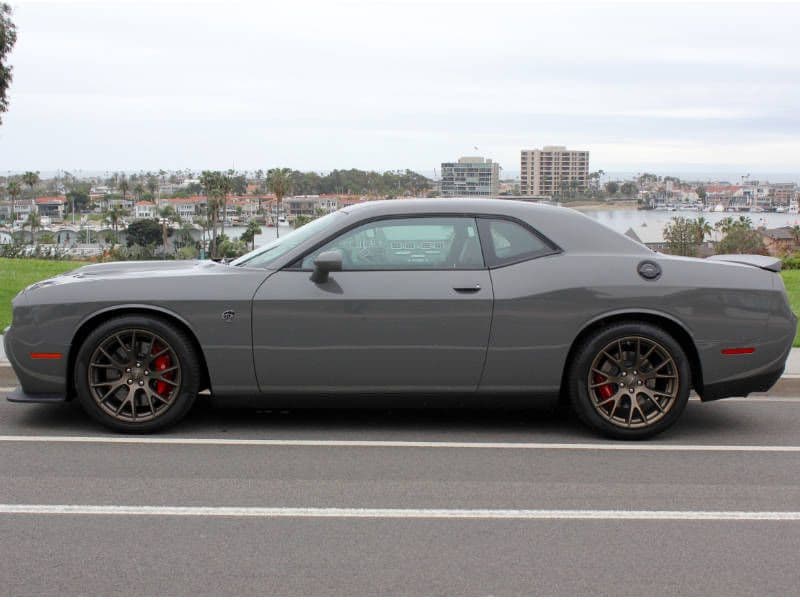
Photo by Miles Branman
Our Take
The Hellcat is not for everyone. It’s loud, titanic, and goes through tires faster than new ones can be shipped to you. It’s also the truest representation of America’s muscle car. The classic styling, old school “bigger is better” performance logic – heck even the name (the Hellcat was a World War II fighter plane) – unapologetically trumpet America’s unique history. Dodge won’t be able to build cars like the Hellcat forever, so if their mantra resonates with you, now’s the time to get with the program.
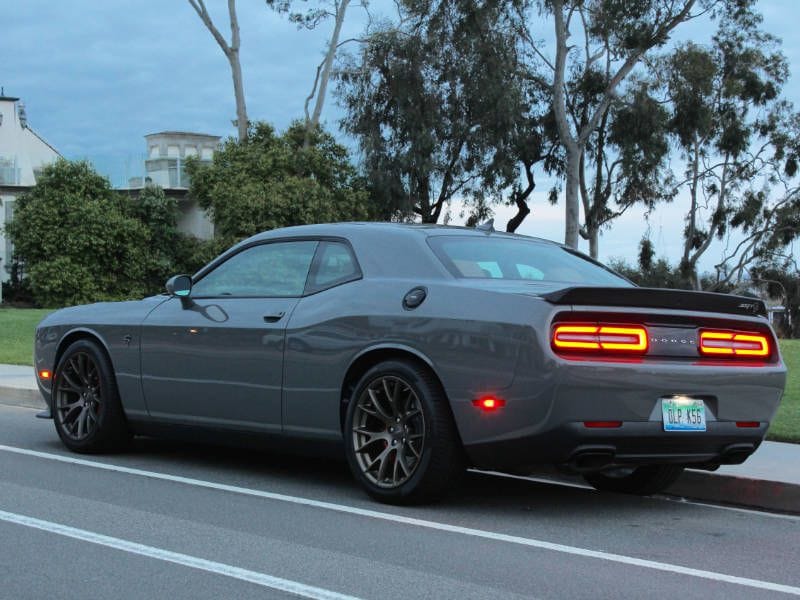
Photo by Miles Branman